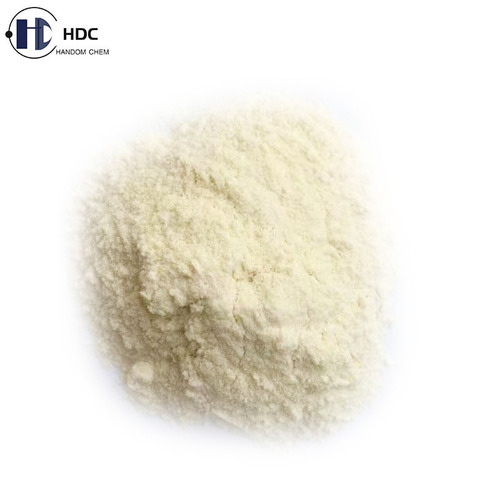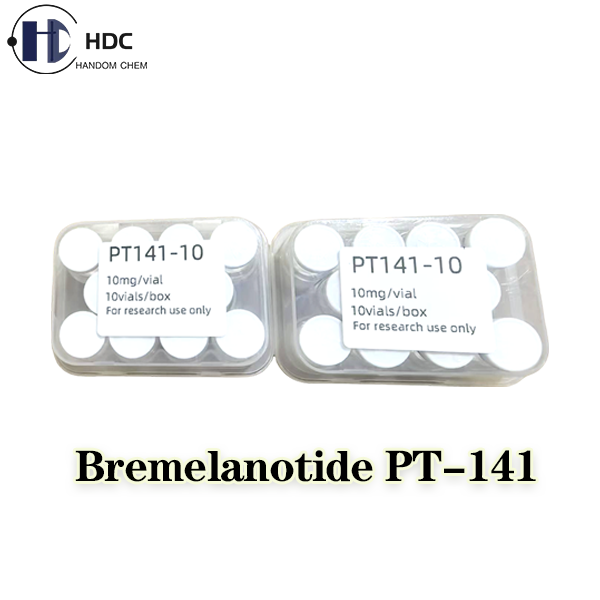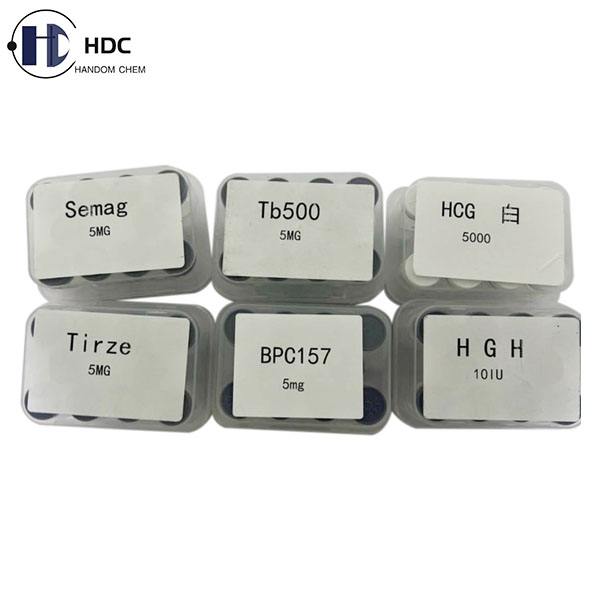--+8615840669648
- Home Page
- Company Profile
-
Our Products
- APIs And Intermediates
- Semaglutide starting material (S)-2-(2-((tert-Butoxycarbonyl)amino)-3-(1-trityl-1H-imidazol-4-yl)propanamido)-2-methylpropanoic acid
- GIPGLP 1 Tirzepatide
- Methylliberine C9H12N4O3
- Dexamethasone CAS No.: 50-02-2
- Betamethasone Dipropionate
- Tetrahydroxydiboron B2H4O4
- (R)-(+)-2-Methyl-2-Propanesulfinamide C4H11NOS
- Maduramicin Ammonium
- O-Phospho-L-Serine H-Ser(PO3H2)-OH
- Semaglutide C187H291N45O59
- Pharma Intermediate Pregnenolone
- Phenothiazine C12H9NS
- Isopropoxyboronic Acid Pinacol Ester
- Tirzepatide intermediate TBuO-Ara-Glu(AEEA-AEEA-OH)-OtBu
- Semaglutide intermediate Fmoc-Lys(tBuO-Ste-Glu(AEEA-AEEA)-OtBu)-OH
- Semaglutide side chain HO-Ste-Glu(AEEA-AEEA-OSu)-OH
- Tirzepatide side chain Fmoc-Lys(TBuO-Ara-Glu(AEEA-AEEA)-OtBu)-OH
- Dehydroepiandrosterone DHEA
- 2-Methyl-2-Propanesulfinamide C4H11NOS
- Eptifibatide Acetate
- Sermaglutide CAS No.: 910463-68-2
- Tranexamic Acid
- Molnupiravir C13H19N3O7
- Cefazolin Sodium Sterile
- Calcium Pyruvate 70%
- 2-acetamido-5-sulfamoyl-1 3 4-thiadiazole Acetazolamide
- Creatine Pyruvate
- Resmetirom intermediate 3,5-Dichloro-4-((6-Chloro-5-Isopropylpyridazin-3-Yl)Oxy)Aniline
- Semaglutide intermediate tBuO-Ste-Glu(AEEA-AEEA-OSu)-OtBu
- (3S)-3-(aminomethyl)-5-methyl-hexanoic acid Pregabalin
- 5-Aminolevulinic Acid Hydrochloride
- Semaglutide side chain TBuO-Ste-Glu(AEEA-AEEA-OH)-OtBu
- Ferric Carboxymaltose
- Vildagliptin 274901-16-5
- Ivermectin CAS No.: 70288-86-7
- Minocycline Hydrochloride
- Sodium 8-(2-hydroxybenzamido)octanoate
- 6- Methyluracil
- Bis(Pinacolato)Diboron C12H24B2O4
- (S)-(-)-2-Methyl-2-Propanesulfinamide C4H11NOS
- Lamivudine C8H11N3O3S
- Terbinafine Hydrochloride
- Levamisole Hydrochloride
- Vosoritide Acetate
- 2-Bromopropene C3H5Br
- Semaglutide delivery excipient Salcaprozate Sodium
- Methyl Salicylate
- Betadex Sulfobutyl Ether Sodium
- Polyvinyl Pyrrolidone
- Pharmaceutical peptide Retatrutide
- Dimethyl Sulfoxide
- Fursultiamine Fursutiamine
- Pharmaceutical Peptide Semaglutide
- Finerenone BAY 94-8862
- Sodium Salicylate
- Dexmedetomidine C13H16N2
- Cagrilintide C194H312N54O59S2
- Mazdutide C210H322N46O67
- Body Protection Compound-157 (BPC157)
- Medetomidine Hydrochloride
- Ruxolitinib Phosphate
- Medetomidine C13H16N2
- Vitamins
- Thiamine Hydrochloride
- Palm Tocotrienols 92%
- Vitamin D3 100000 IU
- D-Alpha Tocopherol 1000IU
- Rice Tocotrienols 85%
- D-Alpha Tocopheryl Acid Succinate 1185IU/g
- Riboflavin Sodium Phosphate
- Folic Acid
- Pyridoxal 5-Phosphate Monohydrate
- D-Alpha Tocopheryl Acetate 1360IU
- D-Panthenol Intrapan
- Pyridoxine Hydrochloride
- DL-Alpha Tocopherol
- D A Tocopherol Acid Succinate
- Mixed Tocopherols
- Vitamin B12 Powder
- Vegan Vitamin D3 Oil
- Vitamin K2 Oil
- D Alpha Tocopheryl Acetate
- D Alpha Tocopherol
- Riboflavin Vitamin B2
- Cyanocobalamin VB12
- Mecobalamin (Methylcobalamin)
- D-Biotin Vitamin H
- Vitamin A Acetate Oil
- Vitamin D3 1000000IU/g Oil
- Vitamin A Palmitate Oil
- Food Ingredients
- DL-Alpha Tocopheryl Acetate
- Nicotinamide Mononucleotide NMN
- Cinnamic Aldehyde
- Sea Cucumber Gonad Peptide
- Glucosamine Hydrochloride
- Inulin Powder
- L-Menthyl Lactate
- Chitosan Glutamate
- Pumpkin Seed Protein Powder
- N-Acetyl-L-Tyrosine CAS No.: 537-55-3
- Sunflower Seed Protein Powder
- (1R, 2S, 5R)-N-(4-Methoxyphenyl)-5-Methyl-2-(1-Methylethyl)Cyclohexanecarboxamide WS-12
- Apple Pectin
- 3-Methyl-10-Ethyl-Deazaflavin C14H13N3O2
- Bovine Collagen Peptide
- Antarctic Krill Oil
- Cooling agent N,2,3-Trimethyl-2-Isopropylbutamide WS-23
- L-Theanine N-ethyl-L-glutamine
- Megastigmatrienone C13H18O
- L-Carnitine Vitamin BT
- Cis-3-Hexenol Leaf Alcohol
- Menthol Acetate
- L-Lactic Acid
- 5-Methyl-2-Phenyl-2-Hexenal C13H16O
- 2,4-Decadienal C10H16O
- Menthyl Isovalerate
- Dihydroactinidiolide C11H16O2
- Geraniol Linalool
- Butyl Butyryllactate
- Cooling agent N-ETHYL-2,2-DIISOPROPYLBUTANAMIDE
- Cooling agent Menthoxypropanediol WS-10
- L-Threonine L-THR
- Beta-Carotene 1%
- Magnesium L-Threonate
- Fish Collagen Peptide
- N-Ethyl-2-(Isopropyl)-5-Methylcyclohexanecarboxamide WS-3
- D-Aspartic Acid CAS No.: 1783-96-6
- Apigenin Versuline
- Neohesperidin Dihydrochalcone
- Fish Oil 18/12 EE
- L-Citrulline CAS No.: 372-75-8
- Oyster Peptide
- Dehydrozingerone C11H12O3
- Mung Bean Protein Powder
- L-Tyrosine Tyr
- Non GMO Natural Flavored Pumpkin Seed Protein
- Xanthan Gum
- 5-allylguaiacol (Eugenol)
- Sorbitol Solution
- Food Grade Alginate Oligosaccharide
- Rice Protein Powder
- Pineapple stem Bromelain
- Lysozyme LZM
- Walnut Peptide
- Chickpea Protein Powder
- Fava Bean Protein
- Food Grade Fructooligosaccharide
- Food Grade Chitosan Oligosaccharide
- Galactomannan GM
- Soya Lecithin Liquid
- Chymosin 600 IMCU/ml
- Chymotrypsin powder
- Amino peptidase
- Alkaline Protease
- Refined Fish Oil (EPA)
- Refined Fish Oil (DHA)
- Refined Fish Oil (EPA/DHA)
- Sea Cucumber Oligopeptide
- Creatine Monohydrate
- Food Grade Chitosan Oligosaccharide
- Modified Citrus Pectin
- L- Serine
- Citrus Pectin
- Sunflower Pectin
- Mung Bean Starch
- Soya Lecithin Powder
- Personal Care Chemicals
- Orotic Acid Anhydrous
- Whitening agent Glabridin 90%
- Hydrolyzed Keratin
- Piroctone Olamine
- Calcium Thioglycolate
- Potassium Cetyl Phosphate
- Cosmetic Peptide Hexapeptide-11
- Lanolin Anhydrous USP23
- Cosmetic Grade Titanium Dioxide
- 2-(Perfluorohexyl)ethyl methacrylate
- Isobornyl Acetate
- Ergothioneine 497-30-3
- Allantoin 5-UREIDOHYDANTOIN
- Kojic Acid
- Hydroquinone Quinol
- APG0810 Alkyl Glucoside
- Octocrylene Octocrilene
- Avobenzone UV 1789
- Polihexanide HCl
- Chlorhexidine Gluconate 20% Solution
- Carbomer 940 Chemical
- Transparent Xanthan Gum
- Lanolin Anhydrous USP40
- 3-O-Ethyl-L-Ascorbic Acid
- N-Carboxy Propionyl Chitosan Sodium
- Sodium Hyaluronate
- Climbazole powder
- Disodium Lauryl Sulfosuccinate 95% Powder
- (-) -Alpha-Bisabolol C15H26O
- Propylene Glycol
- Pharmaceutical Excipients
- Pharmaceutical Grade Magnesium Stearate
- Cholesterol C27H46O
- Pharmaceutical Grade Carboxymethyl Chitosan
- Pharmaceutical Grade Fructose
- Benzoic Acid
- Injection Grade Soya Lecithin
- Tricaprylin 538-23-8
- Salcaprozate Sodium (SNAC)
- 1,2-Dipalmitoyl-Sn-Glycero-3-Phospho-(1-Rac-Glycerol) (Sodium Salt)
- L-A-Lecithin Distearoyl
- Lactose Anhydrous
- POLY(D L-LACTIDE-CO-GLYCOLIDE)
- Lactose Monohydrate
- LNP delivery system excipient mPEG-DSPE-2K
- Sodium Lactate 60% Solution
- Betadex Sulfobutyl Ether Sodium
- Polyvinyl Pyrrolidone (PVP) K90
- 1,2-Dierucoyl-Sn-Glycero-3-Phosphocholine DEPC
- Microcrystalline Cellulose 101
- Pharmaceutical Grade Chitosan Hydrochloride
- Sodium 8-(2-hydroxybenzamido) Octanoate SNAC
- Vitamin E Polyethylene Glycol Succinate
- Pharmaceutical Grade Sodium Stearate
- Methoxypoly (Ethylene Glycol) Dimyristoyl Glycerol-2000
- Pharmaceutical Grade Chitosan
- Microcrystalline Cellulose
- 1,2-Distearoyl-Sn-Glycero-3- Phosphocholine
- Dimethyl Sulfoxide
- ((4-Hydroxybutyl)Azanediyl) Bis(Hexane-6,1-Diyl)Bis(2-Hexyldecanoate)
- Cholesterol (Plant)
- Methoxypoly(Ethylene Glycol) Ditetradecylacetamide
- 2,6-Dimethyl Beta Cyclodextrin (DM-Beta-CD)
- UV Absorbers
- 2-Ethylhexyl Salicylate(Octyl Salicylate)
- 2-Phenylbenzimidazole-5-Sulfonic Acid (UV-T)
- UV Absorber Bemotrizinol
- Benzophenone- 6
- UVA Absorber Avobenzone
- Diethylhexyl Butamido Triazone (HEB)
- Benzophenone-4 (UV-284)
- Water-soluble UVB absorber Ensulizole
- UVA Filter Bisdisulizole Disodium
- Uvinul T 150
- UVA PLUS Diethylamino Hydroxybenzoyl Hexyl Benzoate
- Homosalate HMS
- Oil-soluble UV-B absorber Iscotrizinol C44H59N7O5
- Benzophenone- 12
- Disodium Phenyl Dibenzimidazole Tetrasulfonate
- Octocrilene UV3039
- 2-Ethylhexyl Trans-4-Methoxycinnamate(OMC)
- Benzophenone-3 (UV-9)
- Benzophenone-8 (UV-24)
- Diethylaminohydroxybenzoyl Hexyl Benzoate (UVA Plus)
- Ethylhexyl Triazone (Uvinul T 150)
- Bis-Ethylhexyloxyphenol Methoxyphenyl Triazine
- Methylene Bis-Benzotriazolyl Tetramethylbutylphenol
- Butyl Methoxydibenzoylmethane
- Cosmetic Peptides
- Cosmetic Peptide Sh-Oligopeptide-78
- Palmitoyl Pentapeptide-4
- Myristoyl Hexapeptide-23
- Acetyl Tetrapeptide-5
- Acetyl Octapeptide-3
- Hexapeptide-9 powder
- Palmitoyl Tripeptide-8
- Myristoyl Pentapeptide-4
- Cosmetic Peptide Tetrapeptide-30
- Palmitoyl Tetrapeptide-7
- L-Carnosine BETA-ALANYL-L-HISTIDINE
- Acetyl Tetrapeptide-15
- Cosmetic peptide Nonapeptide-1
- Acetyl Hexapeptide-8
- Palmitoyl Tripeptide-5
- Dipeptide Diaminobutyroyl Benzylamide Diacetate
- Biotinoyl Tripeptide-1
- Surfactants
- Specialty Chemicals
- Chitosan Nitrate
- Sodium Hypophosphite
- Dihydrohonokiol C18H20O2
- 2 2-Dibromo-3-Nitrilopropionamide (DBNPA)
- 5-AMINOLEVULINIC ACID PHOSPHATE
- Sebacic Acid
- Isopropenylboronic Acid Pinacol Ester
- Dibutyl Fumarate
- Chitosan Acetylsalicylate
- P-Hydroxyanisole MEHQ
- Chitosan Azelate
- N-Cyanoacetylurethane C6H8N2O3
- Ethylene Glycol Monobutyl Ether
- Orotic Acid Monohydrate
- Hydroxylamine Hydrochloride
- Bis(Neopentyl Glycolato)Diboron
- Cyclopropylboronic Acid
- Dimethyl Maleate
- Chitosan Salicylate
- Analogous Hyaluronic Acid Chitosan
- Tetrahydrofuran THF
- Chitosan Lactate
- Chloramine B
- Bacillus Thuringiensis
- Acetoacetoxyethyl Methacrylate
- 2-Amino-1-Cyclopentene-1-Carbonitrile C6H8N2
- Spermidine Trihydrochloride
- Agricultural Grade Chitosan Oligosaccharide
- Agricultural Grade Alginate Oligosaccharide
- Urolithin A
- Shiitake Mushroom Chitosan
- 5-Deazaflavin deazaflavin
- Peptide Preparations
- APIs And Intermediates
- Contact Us

- 2-acetamido-5-sulfamoyl-1 3 4-thiadiazole Acetazolamide
- Semaglutide starting material (S)-2-(2-((tert-Butoxycarbonyl)amino)-3-(1-trityl-1H-imidazol-4-yl)propanamido)-2-methylpropanoic acid
- Dehydroepiandrosterone DHEA
- Tirzepatide side chain Fmoc-Lys(TBuO-Ara-Glu(AEEA-AEEA)-OtBu)-OH
- Semaglutide side chain HO-Ste-Glu(AEEA-AEEA-OSu)-OH
- Semaglutide intermediate Fmoc-Lys(tBuO-Ste-Glu(AEEA-AEEA)-OtBu)-OH
- Tirzepatide intermediate TBuO-Ara-Glu(AEEA-AEEA-OH)-OtBu
- Isopropoxyboronic Acid Pinacol Ester
- Phenothiazine C12H9NS
- Pharma Intermediate Pregnenolone
- Semaglutide C187H291N45O59
- O-Phospho-L-Serine H-Ser(PO3H2)-OH
- Maduramicin Ammonium
- (R)-(+)-2-Methyl-2-Propanesulfinamide C4H11NOS
- Tetrahydroxydiboron B2H4O4
- Betamethasone Dipropionate
- Dexamethasone CAS No.: 50-02-2
- Methylliberine C9H12N4O3
- 2-Bromopropene C3H5Br
- (S)-(-)-2-Methyl-2-Propanesulfinamide C4H11NOS
- 2-Methyl-2-Propanesulfinamide C4H11NOS
- Bis(Pinacolato)Diboron C12H24B2O4
- 6- Methyluracil
- Sodium 8-(2-hydroxybenzamido)octanoate
- Minocycline Hydrochloride
- Ivermectin CAS No.: 70288-86-7
- Vildagliptin 274901-16-5
- Ferric Carboxymaltose
- Semaglutide side chain TBuO-Ste-Glu(AEEA-AEEA-OH)-OtBu
- 5-Aminolevulinic Acid Hydrochloride
- (3S)-3-(aminomethyl)-5-methyl-hexanoic acid Pregabalin
- Semaglutide intermediate tBuO-Ste-Glu(AEEA-AEEA-OSu)-OtBu
- Resmetirom intermediate 3,5-Dichloro-4-((6-Chloro-5-Isopropylpyridazin-3-Yl)Oxy)Aniline
- Creatine Pyruvate
- Calcium Pyruvate 70%
- Cefazolin Sodium Sterile
- Molnupiravir C13H19N3O7
- Tranexamic Acid
- Sermaglutide CAS No.: 910463-68-2
- Eptifibatide Acetate
- GIPGLP 1 Tirzepatide
- Vosoritide Acetate
- Levamisole Hydrochloride
- Terbinafine Hydrochloride
- Lamivudine C8H11N3O3S
- Semaglutide delivery excipient Salcaprozate Sodium
- Methyl Salicylate
- Betadex Sulfobutyl Ether Sodium
- Polyvinyl Pyrrolidone
- Pharmaceutical peptide Retatrutide
- Dimethyl Sulfoxide
- Fursultiamine Fursutiamine
- Pharmaceutical Peptide Semaglutide
- Finerenone BAY 94-8862
- Sodium Salicylate
- Cagrilintide C194H312N54O59S2
- Mazdutide C210H322N46O67
- Body Protection Compound-157 (BPC157)
- Ruxolitinib Phosphate
- Medetomidine C13H16N2
- Pyridoxal 5-Phosphate Monohydrate
- Vitamin D3 100000 IU
- Palm Tocotrienols 92%
- D-Alpha Tocopherol 1000IU
- Rice Tocotrienols 85%
- D-Alpha Tocopheryl Acid Succinate 1185IU/g
- Riboflavin Sodium Phosphate
- Folic Acid
- D-Alpha Tocopheryl Acetate 1360IU
- D-Panthenol Intrapan
- DL-Alpha Tocopherol
- Pyridoxine Hydrochloride
- Thiamine Hydrochloride
- D A Tocopherol Acid Succinate
- Mixed Tocopherols
- Vitamin B12 Powder
- Vegan Vitamin D3 Oil
- Vitamin K2 Oil
- D Alpha Tocopheryl Acetate
- D Alpha Tocopherol
- Riboflavin Vitamin B2
- Cyanocobalamin VB12
- Mecobalamin (Methylcobalamin)
- D-Biotin Vitamin H
- Vitamin A Acetate Oil
- Vitamin D3 1000000IU/g Oil
- Vitamin A Palmitate Oil
- (1R, 2S, 5R)-N-(4-Methoxyphenyl)-5-Methyl-2-(1-Methylethyl)Cyclohexanecarboxamide WS-12
- Cooling agent N-ETHYL-2,2-DIISOPROPYLBUTANAMIDE
- L-Threonine L-THR
- Beta-Carotene 1%
- Dehydrozingerone C11H12O3
- Nicotinamide Mononucleotide NMN
- Butyl Butyryllactate
- Magnesium L-Threonate
- Fish Collagen Peptide
- N-Ethyl-2-(Isopropyl)-5-Methylcyclohexanecarboxamide WS-3
- Geraniol Linalool
- Dihydroactinidiolide C11H16O2
- Menthyl Isovalerate
- D-Aspartic Acid CAS No.: 1783-96-6
- 2,4-Decadienal C10H16O
- Apigenin Versuline
- Neohesperidin Dihydrochalcone
- Cooling agent Menthoxypropanediol WS-10
- Fish Oil 18/12 EE
- 5-Methyl-2-Phenyl-2-Hexenal C13H16O
- L-Citrulline CAS No.: 372-75-8
- Oyster Peptide
- DL-Alpha Tocopheryl Acetate
- Mung Bean Protein Powder
- L-Lactic Acid
- Menthol Acetate
- L-Tyrosine Tyr
- Cinnamic Aldehyde
- Sea Cucumber Gonad Peptide
- Glucosamine Hydrochloride
- Cis-3-Hexenol Leaf Alcohol
- L-Carnitine Vitamin BT
- Inulin Powder
- Megastigmatrienone C13H18O
- L-Theanine N-ethyl-L-glutamine
- Cooling agent N,2,3-Trimethyl-2-Isopropylbutamide WS-23
- L-Menthyl Lactate
- Chitosan Glutamate
- Antarctic Krill Oil
- Pumpkin Seed Protein Powder
- Bovine Collagen Peptide
- 3-Methyl-10-Ethyl-Deazaflavin C14H13N3O2
- N-Acetyl-L-Tyrosine CAS No.: 537-55-3
- Sunflower Seed Protein Powder
- Apple Pectin
- Non GMO Natural Flavored Pumpkin Seed Protein
- Xanthan Gum
- 5-allylguaiacol (Eugenol)
- Sorbitol Solution
- Food Grade Alginate Oligosaccharide
- Rice Protein Powder
- Pineapple stem Bromelain
- Lysozyme LZM
- Walnut Peptide
- Chickpea Protein Powder
- Fava Bean Protein
- Food Grade Fructooligosaccharide
- Food Grade Chitosan Oligosaccharide
- Galactomannan GM
- Soya Lecithin Liquid
- Chymosin 600 IMCU/ml
- Chymotrypsin powder
- Amino peptidase
- Alkaline Protease
- Refined Fish Oil (EPA)
- Refined Fish Oil (DHA)
- Refined Fish Oil (EPA/DHA)
- Sea Cucumber Oligopeptide
- Creatine Monohydrate
- Food Grade Chitosan Oligosaccharide
- Modified Citrus Pectin
- L- Serine
- Citrus Pectin
- Sunflower Pectin
- Mung Bean Starch
- Soya Lecithin Powder
- Kojic Acid
- Whitening agent Glabridin 90%
- Calcium Thioglycolate
- Cosmetic Grade Titanium Dioxide
- Hydroquinone Quinol
- Cosmetic Peptide Hexapeptide-11
- Orotic Acid Anhydrous
- Potassium Cetyl Phosphate
- Lanolin Anhydrous USP23
- Ergothioneine 497-30-3
- Isobornyl Acetate
- 2-(Perfluorohexyl)ethyl methacrylate
- Allantoin 5-UREIDOHYDANTOIN
- Hydrolyzed Keratin
- Piroctone Olamine
- APG0810 Alkyl Glucoside
- Octocrylene Octocrilene
- Avobenzone UV 1789
- Polihexanide HCl
- Chlorhexidine Gluconate 20% Solution
- Carbomer 940 Chemical
- Transparent Xanthan Gum
- Lanolin Anhydrous USP40
- 3-O-Ethyl-L-Ascorbic Acid
- N-Carboxy Propionyl Chitosan Sodium
- Sodium Hyaluronate
- Climbazole powder
- Disodium Lauryl Sulfosuccinate 95% Powder
- (-) -Alpha-Bisabolol C15H26O
- Propylene Glycol
- POLY(D L-LACTIDE-CO-GLYCOLIDE)
- Cholesterol C27H46O
- Pharmaceutical Grade Carboxymethyl Chitosan
- Pharmaceutical Grade Fructose
- Benzoic Acid
- Lactose Monohydrate
- LNP delivery system excipient mPEG-DSPE-2K
- Sodium Lactate 60% Solution
- Betadex Sulfobutyl Ether Sodium
- Polyvinyl Pyrrolidone (PVP) K90
- 1,2-Dierucoyl-Sn-Glycero-3-Phosphocholine DEPC
- Microcrystalline Cellulose 101
- Pharmaceutical Grade Chitosan Hydrochloride
- Sodium 8-(2-hydroxybenzamido) Octanoate SNAC
- Vitamin E Polyethylene Glycol Succinate
- Pharmaceutical Grade Sodium Stearate
- Methoxypoly (Ethylene Glycol) Dimyristoyl Glycerol-2000
- Pharmaceutical Grade Chitosan
- Injection Grade Soya Lecithin
- Tricaprylin 538-23-8
- Salcaprozate Sodium (SNAC)
- 1,2-Dipalmitoyl-Sn-Glycero-3-Phospho-(1-Rac-Glycerol) (Sodium Salt)
- L-A-Lecithin Distearoyl
- Lactose Anhydrous
- Pharmaceutical Grade Magnesium Stearate
- Microcrystalline Cellulose
- 1,2-Distearoyl-Sn-Glycero-3- Phosphocholine
- Dimethyl Sulfoxide
- ((4-Hydroxybutyl)Azanediyl) Bis(Hexane-6,1-Diyl)Bis(2-Hexyldecanoate)
- Cholesterol (Plant)
- Methoxypoly(Ethylene Glycol) Ditetradecylacetamide
- 2,6-Dimethyl Beta Cyclodextrin (DM-Beta-CD)
- 2-Ethylhexyl Salicylate(Octyl Salicylate)
- Uvinul T 150
- UVA Filter Bisdisulizole Disodium
- Water-soluble UVB absorber Ensulizole
- Benzophenone-4 (UV-284)
- Benzophenone-8 (UV-24)
- Benzophenone-3 (UV-9)
- 2-Ethylhexyl Trans-4-Methoxycinnamate(OMC)
- Octocrilene UV3039
- Disodium Phenyl Dibenzimidazole Tetrasulfonate
- Benzophenone- 12
- Oil-soluble UV-B absorber Iscotrizinol C44H59N7O5
- Homosalate HMS
- Diethylhexyl Butamido Triazone (HEB)
- UVA Absorber Avobenzone
- Benzophenone- 6
- UV Absorber Bemotrizinol
- 2-Phenylbenzimidazole-5-Sulfonic Acid (UV-T)
- UVA PLUS Diethylamino Hydroxybenzoyl Hexyl Benzoate
- Diethylaminohydroxybenzoyl Hexyl Benzoate (UVA Plus)
- Ethylhexyl Triazone (Uvinul T 150)
- Bis-Ethylhexyloxyphenol Methoxyphenyl Triazine
- Methylene Bis-Benzotriazolyl Tetramethylbutylphenol
- Butyl Methoxydibenzoylmethane
- Cosmetic Peptide Sh-Oligopeptide-78
- Myristoyl Pentapeptide-4
- Palmitoyl Tripeptide-8
- Hexapeptide-9 powder
- Acetyl Hexapeptide-8
- Cosmetic peptide Nonapeptide-1
- Acetyl Tetrapeptide-15
- L-Carnosine BETA-ALANYL-L-HISTIDINE
- Palmitoyl Tetrapeptide-7
- Cosmetic Peptide Tetrapeptide-30
- Acetyl Octapeptide-3
- Acetyl Tetrapeptide-5
- Myristoyl Hexapeptide-23
- Palmitoyl Pentapeptide-4
- Palmitoyl Tripeptide-5
- Dipeptide Diaminobutyroyl Benzylamide Diacetate
- Biotinoyl Tripeptide-1
- Chitosan Nitrate
- P-Hydroxyanisole MEHQ
- Chitosan Acetylsalicylate
- Dibutyl Fumarate
- Isopropenylboronic Acid Pinacol Ester
- Sebacic Acid
- 2-Amino-1-Cyclopentene-1-Carbonitrile C6H8N2
- Acetoacetoxyethyl Methacrylate
- Bacillus Thuringiensis
- Chloramine B
- Chitosan Lactate
- Tetrahydrofuran THF
- Analogous Hyaluronic Acid Chitosan
- Chitosan Salicylate
- Dimethyl Maleate
- Cyclopropylboronic Acid
- Bis(Neopentyl Glycolato)Diboron
- Hydroxylamine Hydrochloride
- Orotic Acid Monohydrate
- Ethylene Glycol Monobutyl Ether
- N-Cyanoacetylurethane C6H8N2O3
- 5-AMINOLEVULINIC ACID PHOSPHATE
- 2 2-Dibromo-3-Nitrilopropionamide (DBNPA)
- Dihydrohonokiol C18H20O2
- Sodium Hypophosphite
- Chitosan Azelate
- Spermidine Trihydrochloride
- Agricultural Grade Chitosan Oligosaccharide
- Agricultural Grade Alginate Oligosaccharide
- Urolithin A
- Shiitake Mushroom Chitosan
- 5-Deazaflavin deazaflavin
Most Popular Products
Peptide Preparations |
|
|
×
Add a mobile number to receive call from "DALIAN HANDOM CHEMICALS CO.,LTD."
×
Enter OTP
×
Share additional details for a quick response
×
Thank You!
Thank You for your valuable time. We have received your details and will get back to you shortly.
×
Get a price quote for Cathelicidin LL-37 (Human)
×
Contact Details
DALIAN HANDOM CHEMICALS CO.,LTD.
RM702, Unit 1, Building 21, Liuhe Road, Ganjingzi Dist,Dalian - 116091, Liaoning, China
Phone :--+8615840669648
E-mail us : export@handom-chem.com
 |
DALIAN HANDOM CHEMICALS CO.,LTD.
All Rights Reserved.(Terms of Use) Developed and Managed by Infocom Network Private Limited. |
✕
Contact Us
Name
Comapny Name
Phone Number
Email Id
City / State

OTP Verification
Verification Code
Did not receive yet?
Resend OTP

Thank you!
We have received your requirements
For an immediate response, please call this
number +8615840669648
✕
Tell us about your requirement

Price:
Quantity
Select Unit
- 50
- 100
- 200
- 250
- 500
- 1000+
Additional detail
Mobile number
Email
Name
Comapny Name
Phone Number
Email Id
City / State
Confirm Your Requirement
Verification Code
Did not receive yet?
Resend OTP

Youre Done!
We have received your requirements and will reply shortly with the best price.
Products You May Like




